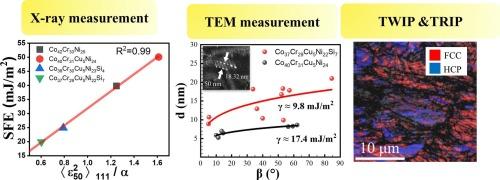Si-induced stacking fault energy modulation and its impact on deformation mechanisms in non-equimolar CoCrCuNi alloys
IF 5.5
2区 材料科学
Q1 MATERIALS SCIENCE, CHARACTERIZATION & TESTING
引用次数: 0
Abstract
X-ray diffraction is utilized to estimate the stacking fault energy (SFE) of the alloy prior to conducting the mechanical test in this research. Subsequently, transmission electron microscopy (TEM) is employed to measure the widths of partial dislocation in specimens subject to tensile testing, enabling the determination of the SFE in the CoCrCuNiSi medium-entropy alloy. The alloys are prepared with small quantities of silicon to investigate its effects on SFE, specifically in three face-centered cubic low SFE alloys. The parameters necessary for SFE calculations are determined by digital image correlation to gain Poisson's ratio and nanoindentation to determine Young's modules. Furthermore, the subsequent mechanical property evaluations are performed to corroborate the precision of both measurements. Observations of the deformed microstructure using electron backscatter diffraction and TEM revealed that the reduction in SFE promotes the mechanisms of twinning-induced plasticity and transformation-induced plasticity effects, thereby contributing to an enhancement in the alloy's strength. The findings substantiate the correlation between SFE and the deformation mechanisms, highlighting the potential for optimizing alloy properties through the addition of minor elements.

非等摩尔CoCrCuNi合金硅致层错能调制及其对变形机制的影响
本研究在进行力学试验之前,利用x射线衍射对合金的层错能(SFE)进行估算。随后,利用透射电子显微镜(TEM)测量拉伸试验试样的部分位错宽度,从而确定CoCrCuNiSi中熵合金的SFE。用少量硅制备合金,研究其对三种面心立方低SFE合金的影响。计算所需的参数是通过数字图像相关来获得泊松比和纳米压痕来确定杨氏模。此外,进行了随后的力学性能评估,以证实这两种测量的精度。利用电子背散射衍射和透射电镜对合金变形组织的观察表明,SFE的降低促进了合金的孪晶诱导塑性和相变诱导塑性机制,从而提高了合金的强度。研究结果证实了SFE与变形机制之间的相关性,强调了通过添加少量元素来优化合金性能的潜力。
本文章由计算机程序翻译,如有差异,请以英文原文为准。
求助全文
约1分钟内获得全文
求助全文
来源期刊

Materials Characterization
工程技术-材料科学:表征与测试
CiteScore
7.60
自引率
8.50%
发文量
746
审稿时长
36 days
期刊介绍:
Materials Characterization features original articles and state-of-the-art reviews on theoretical and practical aspects of the structure and behaviour of materials.
The Journal focuses on all characterization techniques, including all forms of microscopy (light, electron, acoustic, etc.,) and analysis (especially microanalysis and surface analytical techniques). Developments in both this wide range of techniques and their application to the quantification of the microstructure of materials are essential facets of the Journal.
The Journal provides the Materials Scientist/Engineer with up-to-date information on many types of materials with an underlying theme of explaining the behavior of materials using novel approaches. Materials covered by the journal include:
Metals & Alloys
Ceramics
Nanomaterials
Biomedical materials
Optical materials
Composites
Natural Materials.
 求助内容:
求助内容: 应助结果提醒方式:
应助结果提醒方式:


